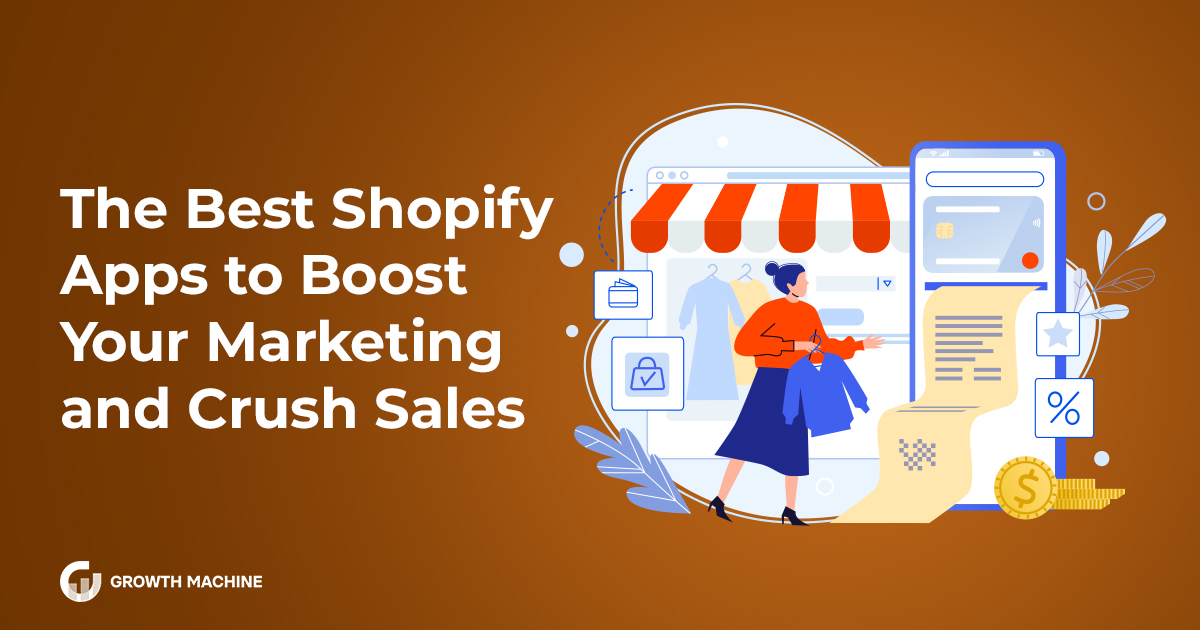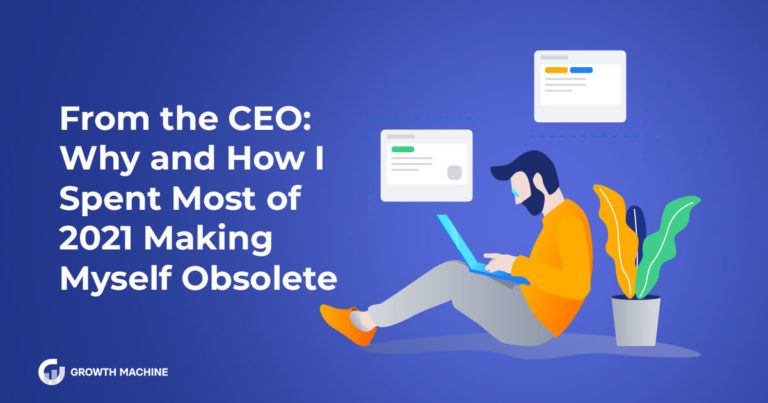The Best Shopify Apps to Boost Your Marketing and Crush Sales
Whether you’re a new merchant or a Shopify veteran, this is for certain: You’ll always need good marketing to drive people to purchase.
You may have a great product, a beautiful site, and a gung-ho attitude, but if you don’t have the tools to flaunt what you’ve got, you’ll be hard-pressed to acquire customers. Where there are no customers, there are no sales. Where there are no sales, there is no profit.
Womp womp.
Fortunately, Shopify boasts a ton of marketing apps that integrate seamlessly into their platform. But we do mean a ton. (Around 1,100 at last count.)
All those options can be overwhelming, particularly if your knowledge of what you actually need is limited. What’s more, there are about a billion marketing tactics, and everyone has an opinion about which works best.
With all this noise, how are you supposed to find the approach — and subsequent application(s) — that will work for you? We at Tako Agency have you covered.
There are four marketing methods that are most relevant to ecommerce: email, content, loyalty, and social proof. Ahead, we’ll explain each and recommend some of the best apps in the biz.
Email Marketing
Email marketing, sometimes referred to as retention marketing, is often used to build relationships with customers, highlight new products or services, offer incentives, and make announcements — all to a captive audience (read: people who have opted onto your subscriber list).
This marketing approach plays a critical role in turning one-time customers into loyal, repeat customers.
Top Pick: Klaviyo
Klaviyo is an all-inclusive application that leverages sophisticated, securely -stored customer data, clear logic paths, and beautiful visual flows to create the most personalized email and SMS marketing experience modern technology will allow — both for you and your customers.
Need proof it works? The pros at Slice & Dice used Klaviyo to boost Cup & Leaf’s email revenue by over 206% in just 30 days.
How Difficult Is It To Set Up?
Integrating Klaviyo with Shopify is simple, and you can trigger the integration either from your Shopify app store or from an existing Klaviyo account. There are a few additional steps that may appear intimidating at first — like setting up web tracking — but Klaviyo explains it all.
Web tracking is helpful because it collects valuable information from “known browsers” (people interacting with specific areas of your site) and stores it in your dashboard to be used for targeted email campaigns and data-driven business decisions.
Klaviyo is an exceptionally robust, complex system, so the learning curve can be a bit steep. Those with a development background may have an easier time, but anyone can hack it with enough time and determination. (If not, you can hire a Klaviyo expert to do the heavy lifting for you.)
What Will It Cost and What’s the ROI?
Klaviyo’s pricing is based on the number of email subscribers you have. They have a handy calculator on their website that can help you estimate your monthly cost.

Their calculator also includes an ROI estimator. All you need to know is your number of subscribers and your total average annual sales. It’s just an estimate based on industry data and information from past users, but it’s gratifying to see the platform’s potential benefits upfront.

Runner Up: Privy
Like Klaviyo, Privy is a popular SMS and email marketing option for Shopify merchants. It’s less expensive than Klaviyo (30,000 contacts will run you about $160 per month on the email- only plan) and simpler.
If you’re just beginning to dip your toes into email marketing, you might find Privy more user-friendly than Klaviyo. That said, it’s not quite as advanced or sophisticated (fewer integrations, flows, triggers, and conditions) so you may outgrow it eventually.
Content Marketing
Content marketing comes in many shapes, but it can be most succinctly defined as:
“… a strategic marketing approach focused on creating and distributing valuable, relevant, and consistent content to attract and retain a clearly defined audience — and, ultimately, to drive profitable customer action.” [Content Marketing Institute]
“Content” covers everything from social media posts to written blog content to tutorial videos, and more. The benefits of content marketing can be jaw-dropping: heightened brand awareness, enhanced authority and credibility in your industry, increased cultural relevance, and less money spent on boring traditional advertising — all leading to record-breaking sales.
At first glance, content marketing seems to offer the biggest bang for your buck — after all, it’s basically free, right?! You can write your own blog posts, do your own SEO research, take your own Instagram snaps, and make your own product videos.
Technically, yes — but there are very few merchants out there with the writing, editing, design, photography, and software skills to do it well…and content marketing only works when it’s done well. (Besides, who has the time?)
Our best advice? Content marketing can be fantastic, but be methodical: Take a step back and ask yourself, “Is it actually right for my business?” The moment the answer to that question is an unequivocal “YES,” check out these content marketing heavyweights.*
*Note: Written content for blogs cannot be handled sufficiently by a mere app — –at least, not until AI content writing moves along a little further. You’ll need an agency for that.
Top Pick: Promo.com

Widely popular Promo makes it easy to create engaging videos that can boost conversions and even be shared directly to social media with a single click. If you’re not an experienced video editor (and you don’t want to fight with iMovie for hours), tools like this make video creation a piece of cake.
How Difficult Is It To Set Up?
Promo is easy to set up and get started with. Their support team is responsive, and their knowledge base for self-starters is enormous. They even offer a free calendar to help you plan out your promotions month -by -month.
What Will It Cost and What’s the ROI?
Promo starts at $39/month and ramps up to $249/month depending on your needs, but there’s a free version available through Shopify to get your feet wet.
It’s tough to assign a specific ROI to adding a video component to your promotional plans, but video has been consistently increasing in popularity. (Like, really popular. The Digital Marketing Institute reported that 80% of traffic would be attributed to video by 2021.)
Runner Up: Covet Pics

Instagram apps are a dime a dozen on the Shopify App Store, and there are several with high reviews — but Covet Pics edges out its competitors thanks to its hyper-sophisticated designs and layouts that appeal to high-end brands. Plug in this bad boy and build shoppable Instagram feeds, lookbooks, and galleries in minutes. Their customer service team also wins a gold star for their quick response time and helpfulness.
Loyalty Marketing
Loyalty marketing incentivizes current customers to repeatedly give you their business. If you’re part of at least one rewards program (and honestly, who isn’t?), you know how effective it can be.
Here’s why loyalty marketing is so important:
- It’s cost-effective. Although many loyalty programs involve giving special discounts or freebies, the cost per acquisition for new customers acquired through other means will likely be much higher than what you “lose” by offering promotions to loyalty program members.
- It caters to a captive audience. It’s almost always easier to get a customer to purchase from you again than to convince a stranger that you’re their best bet.
- It gives you the goods (data). Customer data is the most valuable commodity in your business arsenal. It helps you understand your demographic, informs what products or services you should promote and when, allows you to create more targeted advertising*, and more.
*Be careful with this one. There’s a fine line between making helpful suggestions based on past behavior, and terrifying a customer with an ad for a feline treadmill moments after he mentions to a friend that the cat was looking a little plump. (Looking at you, Instagram/Facebook.) - It encourages loyalty (duh). Take subscription giant Amazon Prime (yep, that’s a loyalty program), for example. Upon Prime’s inception in 2005, Amazon’s chief objective was to stop customers from abandoning their carts due to high shipping rates. By 2018, Prime members were spending over twice as much as non-Prime members — –and that gap continues to grow.
Top Pick: Smile.io
Smile.io is a high-powered loyalty program builder that allows you to reward customers with points, a VIP program, referral incentives, or a combo of all three. You decide what actions should merit rewards, what the rewards are, and how they can be redeemed — all from a supremely clean, intuitive admin dashboard.
Smile.io integrates so seamlessly with Shopify that a fully responsive rewards badge appears on your website the moment you activate your program. The badge is entirely customizable and allows site visitors to learn about your program and sign up.


What’s more, Smile integrates with email marketing gold medalist Klaviyo, so you can keep your program members engaged with vibrant, on-brand emails.
Feel that? That’s you becoming a relationship-building, customer-satisfying ecommerce wizard.
How Difficult Is It to Set Up?
You could spend more time making a cup of coffee than you will setting up your Smile.io app. The most time-consuming part will likely be deciding the framework for your loyalty program. The platform setup itself is a breeze.
What Will It Cost and What’s the ROI?
Smile.io offers five plans. The Free and Starter plans will get your loyalty program off the ground, but the goodies really start kicking in at the Growth level. VIP program access is available at the Pro level, and Enterprise gets you the whole enchilada — including API access and custom HTML reward program emails.
Free: $0
Starter: $49/month
Growth: $199/month
Pro: $599/month
Enterprise: $1,000+/month
You can check out all the plans — and compare features — here.
Runner Up: Growave
Growave is similar to Smile.io in that its core focus is building effective loyalty programs, but it goes a step further by including a wishlist feature, a reviews function, and several social integrations to enable social proof. This does complicate things a bit, and because there’s a lot going on, loyalty is not their core focus as it is for Smile.
Social Proof Marketing
Social proof marketing hinges on the psychological phenomenon commonly known as “groupthink”, or “herd mentality”: a large group of people (or a small group of the right people) say a behavior is desirable, so an individual conforms to that behavior.
You don’t have to be a conformist drone to fall victim to the psychology of social proof; it happens to everyone, almost every day.
Imagine you drive by two restaurants on the way home from work every evening. Restaurant One always has a crowd outside waiting to be seated. Restaurant Two is a ghost town. When date night rolls around, which of those restaurants is more likely to come to mind? That’s social proof in action.
One of the most common social proof tools is the almighty review. When it comes to online shopping, reviews are critical. Shopping in a physical store allows customers to touch products, compare their qualities, and make a decision without much outside help. In fact, 69% of in-store shoppers would rather consult a product review on their phone than ask a store associate. When comparing products online, that sensory input is not available — so we turn to confirmation from others.
Reviews aren’t the only way to employ social proof marketing. You also have:
- In-depth testimonials (“This is my favorite product.”)
- Expert, influencer, and celebrity endorsements (“I hold an esteemed position in society and this is my favorite product.”)
- Large, authentic social media followings (“We are a large group of people and this is our favorite product. See us loving it in these photos!”)
- Awards and certifications (“We are a trusted certifying agency and we endorse this product.”)
- Friends and family (“I am someone you know and trust. I have used this product and it’s my favorite!”)
Top Pick: Yotpo

Yotpo allows you to proudly display social proof in a couple of different ways. The first way taps into the awesome power of reviews by giving your customers a plethora of (non-annoying) opportunities to share their thoughts.
In fact, Yotpo’s support for reviews makes it the gold standard, offering features like review request emails, community Q&A, customizable review widgets for on-site reviews, and coupons to incentivize customers to leave reviews.
The second way Yotpo can bulk up your social proof is through brilliant visual UGC (user-generated content). That might mean adding a shoppable Instagram feed of consumer-created images to your homepage, or incorporating galleries on your product pages to show products in action.
Yotpo also allows you to show off customer content on the checkout page — which discourages cart abandonment and can be used to upsell recommended products.
How Difficult Is It to Set Up?
Yotpo isn’t super difficult to set up, but as it’s a robust piece of software, it might take some time to learn the ropes. You may also need help from a developer to get the code snippet set up correctly on the pages where you want the widget to appear.
Some apps can be managed right in your Shopify admin console port-setup, but Yotpo isn’t one of them. You’ll be bounced out to their site instead. There, you can make customizations to the widget, view your analytics, use the built-in review collection tool, and more.
What Will It Cost and What’s the ROI?
Yotpo offers a free version of its platform, but benefits are limited. Their Premium plan is not a one-size-fits-all solution, either. Instead, Yotpo considers your store’s needs and encourages setting up a demo to determine what features will best suit your shop.
For small brands, Yotpo recommends their Growth plan, which starts at $19/month:
“The Growth plan operates on a tiered pricing model according to the number of orders your business has per month, up to 500 orders. For more details visit our Growth page.”
Runner Up: Reviews.io
Reviews.io is a licensed Google Review Partner. Reviews collected with their platform will award those widely recognized Google review stars (which you can embed into product pages) and boost your Google quality score, driving down cost-per-click.
When you add retargeting ads, photo and video reviews, automated social sharing, comprehensive reporting, branded review invitation emails, and competitor analysis, you’re well on your way to legendary customer trust.
Deciding Where To Start
There are several factors to consider when choosing which types of marketing will best suit your store. To guide your decision-making process, consider these three components: your greatest need, your budget, and your desired duration of commitment to the approach.
1. Greatest Need
What is your ultimate goal? Are you engaging current customers, or acquiring new ones? Do you want to increase general brand awareness, or enhance customer trust
Chances are good you’ll have several objectives in mind, so try to zero in on one or two at a time — and be specific.
🚫 “Get more sales.”
✅ “My email campaigns have an average conversion rate of 2%. I currently have 4,000 subscribers. I need to acquire at least 1,000 more subscribers to consistently reach my goal of 100 sales per month.”
It would seem like email marketing is the obvious answer to achieve this objective — but perhaps not. Email marketing itself is not a list growth tool; it’s a marketing tool for those already on your list.
Content marketing may work, but it would likely take effect slowly. For this purpose, we’d suggest loyalty marketing: Incentivize your existing audience to refer members of their networks to your store. With this approach, you build loyalty in your current customer pool and your subscriber list grows — win/win!
2. Budget
How much do you have to spend? Be honest with yourself. Some approaches, such as social proof, rely more heavily on tools than (wo)man power, so you’d just need to consider the cost of the platform and the time to set it up properly.
Other methods are more sophisticated — like content marketing. Creating and distributing content effectively includes needing work from:
- Writers
- Photographers
- Influencers
- SEO experts
- Designers
- Project managers
…You get the idea. Make sure you’re considering your approach from both short- and long-term angles. The best marketing strategies contain a mix of affordable, quickly deployed strategies (loyalty marketing) and long-term investments (content marketing).
3. Desired Duration of Commitment
Some marketing methods are better suited to merchants that need a “quick fix,” while others are an investment. Neither is inherently better than the other; it all depends on what you need.
If you’re a new brand looking to quickly gain traction in the market, your primary goal is brand awareness. You don’t want to get mired in long-term strategies right from the get-go. Y; you want to take just as much time as you need to get your ducks in a row, and then start shouting from the rooftops that you have arrived. Social proof and loyalty marketing are best suited to these kinds of campaigns.
By contrast, imagine you’re an established brand launching a new product. You have some time on the market under your belt, consistent sales, and resources at your disposal (such as content creators or a healthy email subscriber base). Because your brand awareness is in good standing and you have a current customer base, your core business will stay afloat while you invest in introducing the latest and greatest. Solid content and email marketing are great ways for an established brand to successfully roll out new offerings.
Do What Works for You
Whichever road(s) you choose, remember that above all, you’ll only discover what works for you through trial and error. Give each tool a chance — a real chance. Set it up well to maximize its efficiency and give it enough time to determine if it’s actually going to work. Be realistic about the outcome you can expect.
Once you start to see results, make tweaks and adjustments to keep those lines going up and to the right. Good luck!







